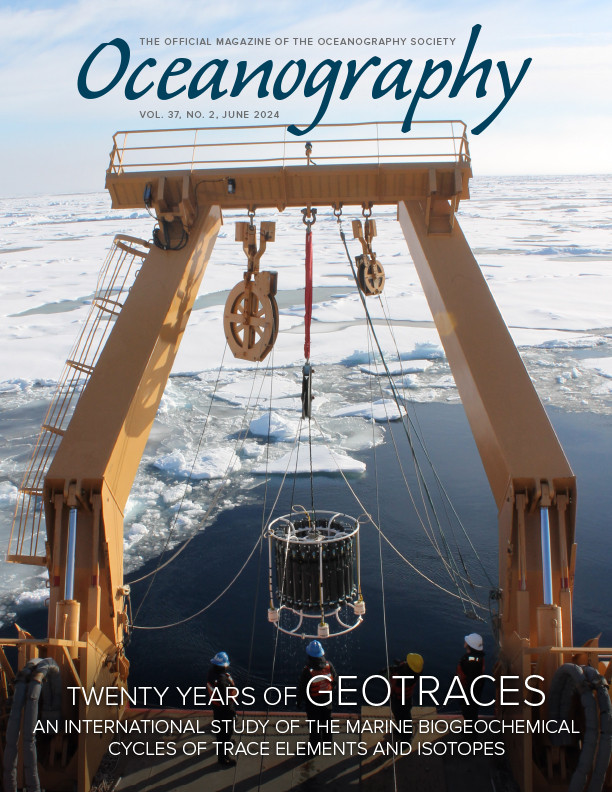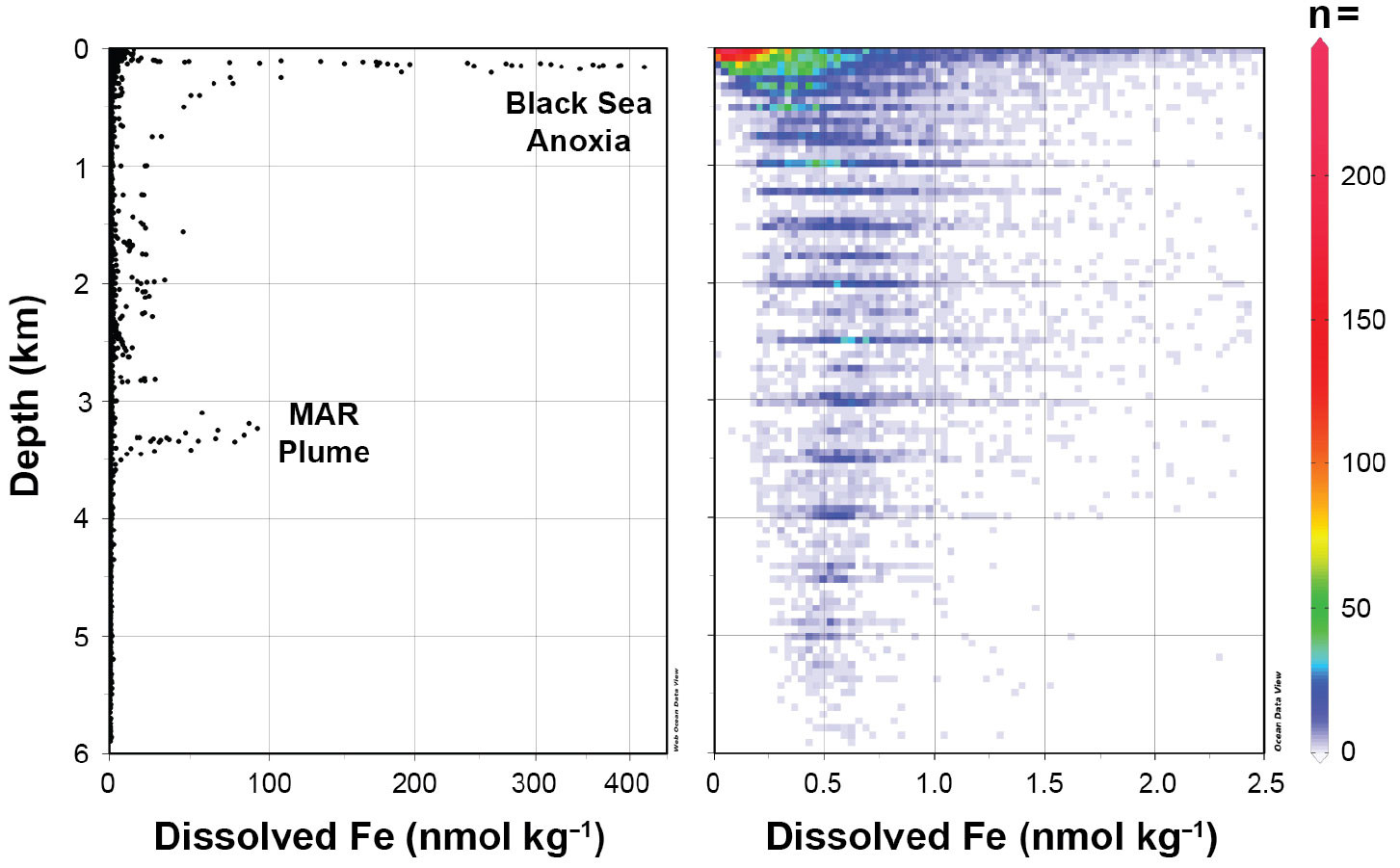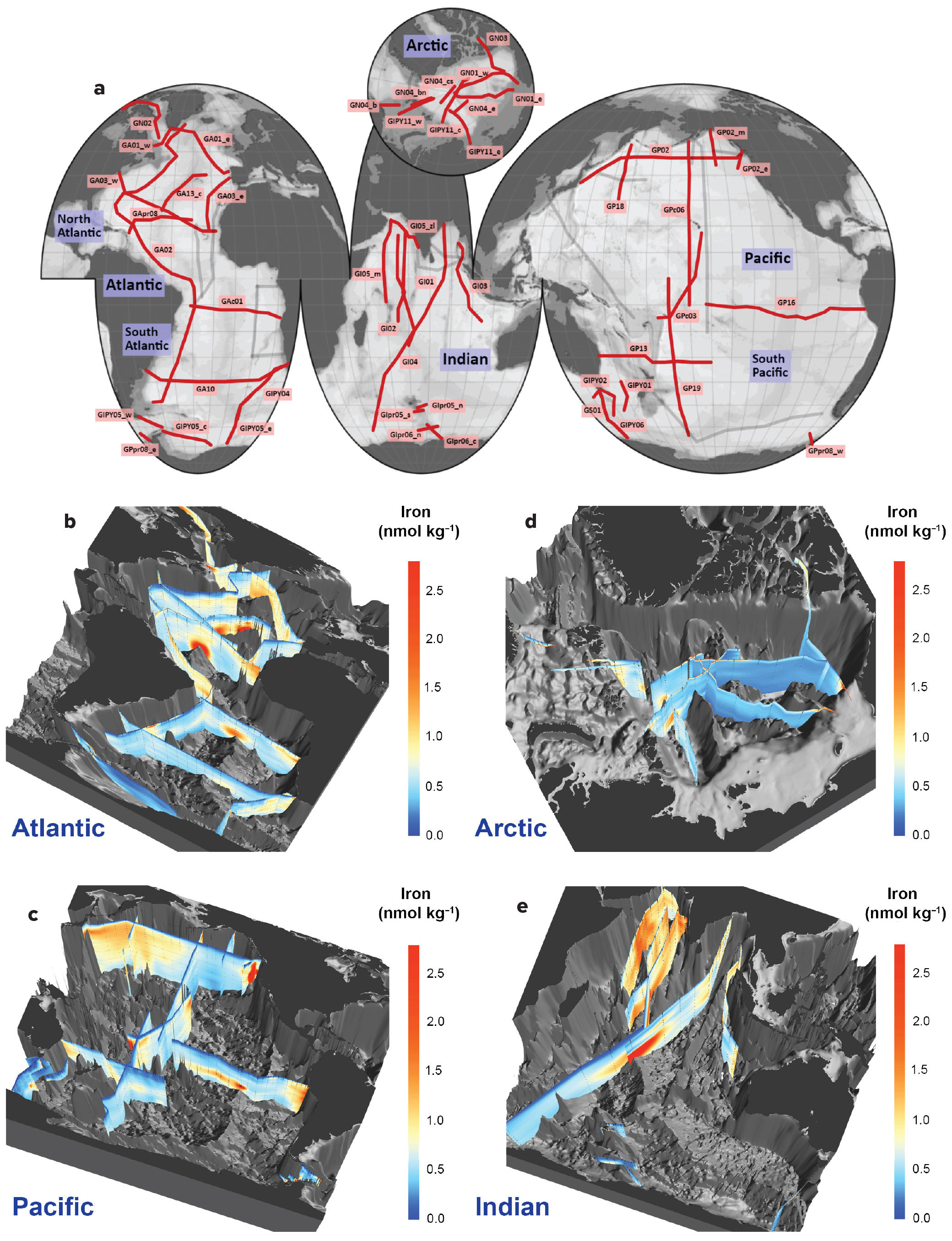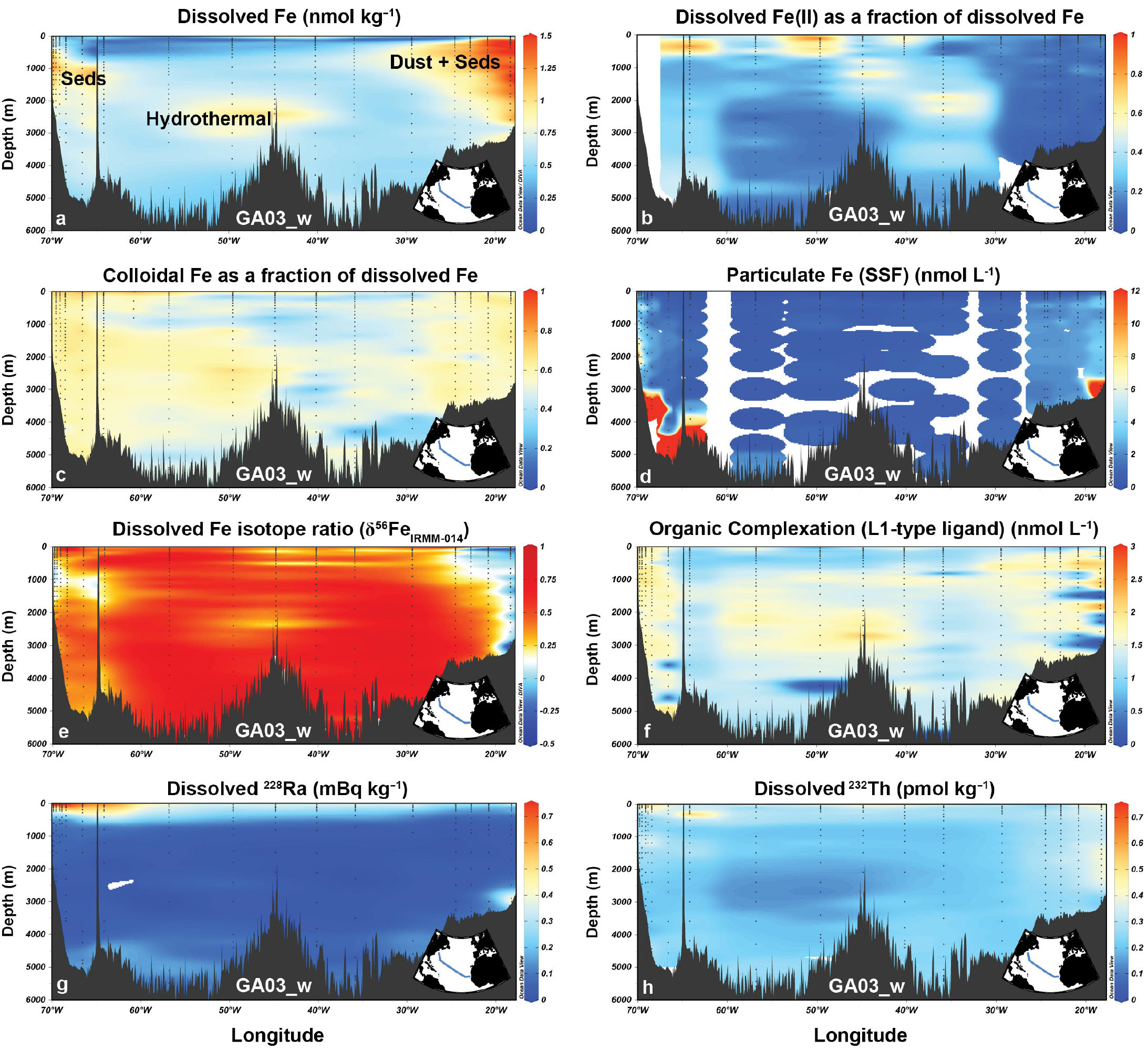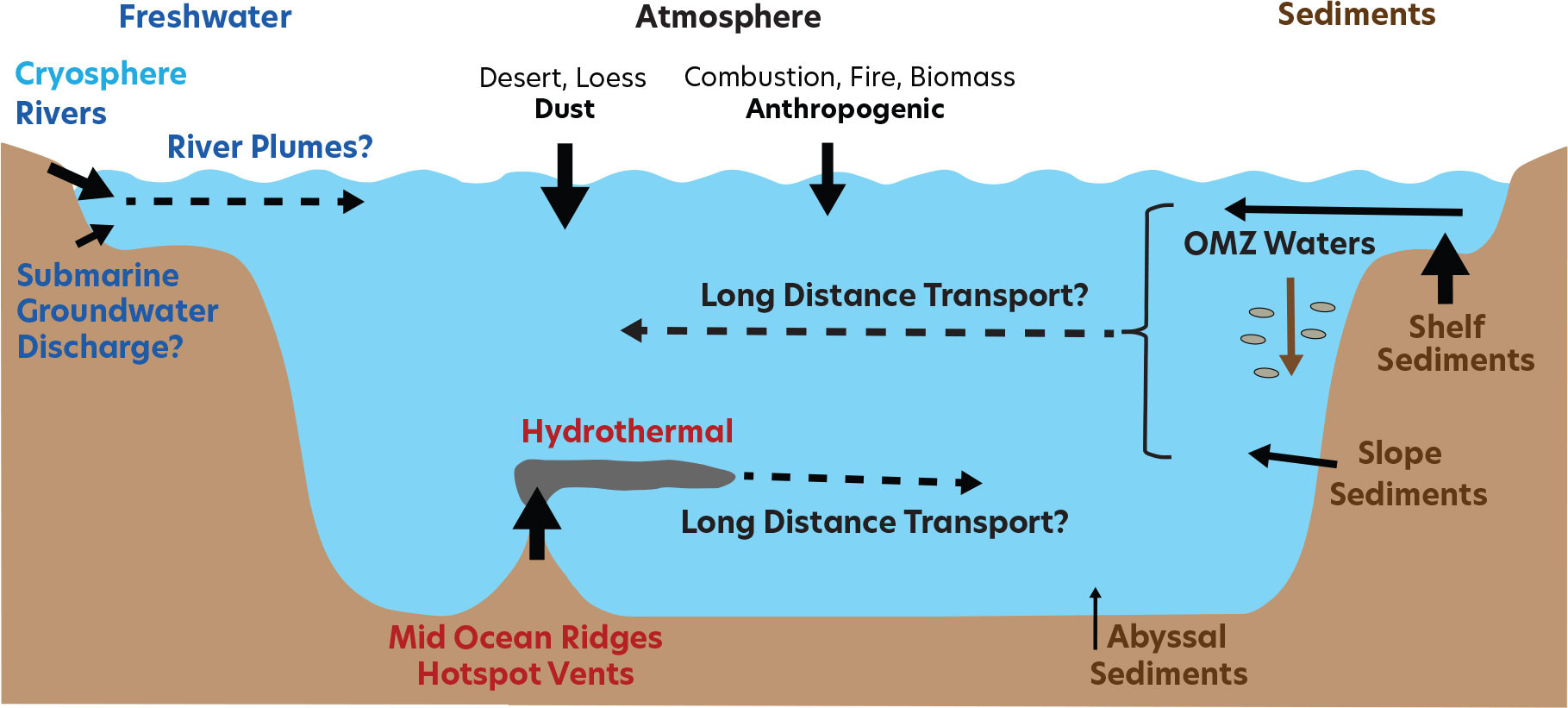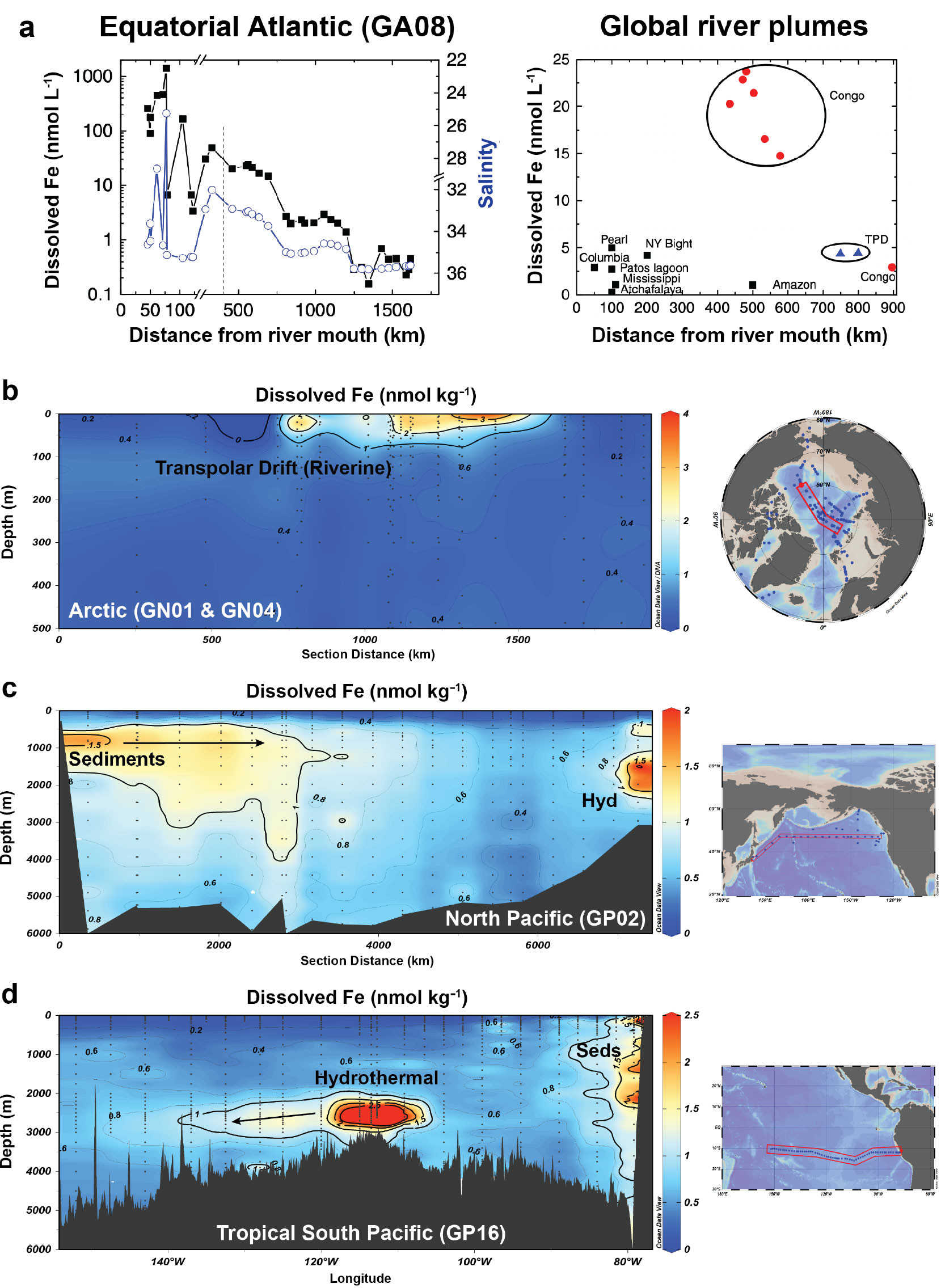Aguilar-Islas, A., H. Planquette, M.C. Lohan, W. Geibert, and G. Cutter. 2024. Intercalibration: A cornerstone of the success of the GEOTRACES program. Oceanography 37(2):21–24, https://doi.org/10.5670/oceanog.2024.404.
Anderson, R.F., E. Mawji, G.A. Cutter, C. Measures, and C. Jeandel. 2014. GEOTRACES: Changing the way we explore ocean chemistry. Oceanography 27(1):50–61, https://doi.org/10.5670/oceanog.2014.07.
Anderson, R.F. 2020. GEOTRACES: Accelerating research on the marine biogeochemical cycles of trace elements and their isotopes. Annual Reviews of Marine Science 12:49–85, https://doi.org/10.1146/annurev-marine-010318-095123.
Anderson, R.F. 2024. GEOTRACES reflections. Oceanography 37(2):8–12, https://doi.org/10.5670/oceanog.2024.405.
Ardyna, M., L. Lacour, S. Sergi, F. D’Ovidio, J.-B. Sallée, M. Rembauville, S. Blain, A. Tagliabue, R. Schlitzer, C. Jeandel, and others. 2019. Hydrothermal vents trigger massive phytoplankton blooms in the Southern Ocean. Nature Communications 10:2451, https://doi.org/10.1038/s41467-019-09973-6.
Birchill, A.J., A. Milne, E.M.S. Woodward, C. Harris, A. Annett, D. Rusiecka, E.P. Achterberg, M. Gledhill, S.J. Ussher, P.J. Worsfold, and others. 2017. Seasonal iron depletion in temperate shelf seas. Geophysical Research Letters 44(17):8,987–8,996, https://doi.org/10.1002/2017GL073881.
Blain, S., B. Queguiner, L. Armand, S. Belviso, B. Bombled, L. Bopp, A. Bowie, C. Brunet, C. Brussaard, F. Carlotti, and others. 2007. Effect of natural iron fertilization on carbon sequestration in the Southern Ocean. Nature 446:1,070–1,074, https://doi.org/10.1038/nature05700.
Boyd, P.W., T. Jickells, C.S. Law, S. Blain, E.A. Boyle, K.O. Buesseler, K.H. Coale, J.J. Cullen, H.J.W. De Baar, M. Follows, and others. 2007. Mesoscale iron enrichment experiments 1993–2005: Synthesis and future directions. Science 315:612–617, https://doi.org/10.1126/science.1131669.
Boyd, P.W., and M.J. Ellwood. 2010. The biogeochemical cycle of iron in the ocean. Nature Geoscience 3:675–682, https://doi.org/10.1038/ngeo964.
Boyle, E.A., J.M. Edmond, and E.R. Sholkovitz. 1977. The mechanism of iron removal in estuaries. Geochimica et Cosmochimica Acta 41:1,313–1,324, https://doi.org/10.1016/0016-7037(77)90075-8.
Boyle, E.A., S.G. John, W. Abouchami, J.F. Adkins, Y. Echegoyen-Sanz, M.J. Ellwood, A.R. Flegal, K. Fornace, C. Gallon, and S.J.G. Galer. 2012. GEOTRACES IC1 (BATS) contamination-prone trace element isotopes Cd, Fe, Pb, Zn, Cu, and Mo intercalibration. Limnology and Oceanography Methods 10:653–665, https://doi.org/10.4319/lom.2012.10.653.
Bruland, K., R.P. Franks, G.A. Knauer, and J.H. Martin. 1979. Sampling and analytical methods for the determination of copper, cadmium, zinc, and nickel at the nanogram per liter level in sea water. Analytica Chimica Acta 105:233–245, https://doi.org/10.1016/S0003-2670(01)83754-5.
Bruland, K., and M.C. Lohan. 2003. Controls of trace metals in seawater. Pp. 23–47 in Treatise On Geochemistry. K.K. Turekian and H.D. Holland, eds, Elsevier Science Ltd., Cambridge, United Kingdom, https://doi.org/10.1016/B0-08-043751-6/06105-3.
Buck, K.N., B. Sohst, and P.N. Sedwick. 2015. The organic complexation of dissolved iron along the U.S. GEOTRACES (GA03) North Atlantic Section. Deep Sea Research Part II 116:152–165, https://doi.org/10.1016/j.dsr2.2014.11.016.
Buck, C.S., S. Fietz, D.S. Hamilton, T.-Y. Ho, M.M.G. Perron, and R.U. Shelley. 2024. GEOTRACES: Fifteen years of progress in marine aerosol research. Oceanography 37(2):116–119, https://doi.org/10.5670/oceanog.2024.409.
Charette, M.A., P.J. Morris, P.B. Henderson, and W.S. Moore. 2015. Radium isotope distributions during the US GEOTRACES North Atlantic cruises. Marine Chemistry 177:184–195, https://doi.org/10.1016/j.marchem.2015.01.001.
Charette, M.A., P.J. Lam, M.C. Lohan, E.Y. Kwon, V. Hatje, C. Jeandel, A.M. Shiller, G.A. Cutter, A. Thomas, P.W. Boyd, and others. 2016. Coastal ocean and shelf-sea biogeochemical cycling of trace elements and isotopes: Lessons learned from GEOTRACES. Philosophical Transactions of the Royal Society A 374:20160076, https://doi.org/10.1098/rsta.2016.0076.
Charette, M.A., L.E. Kipp, L.T. Jensen, J.S. Dabrowski, L.M. Whitmore, J.N. Fitzsimmons, T. Williford, A. Ulfsbo, E. Jones, R.M. Bundy, and others. 2020. The Transpolar Drift as a source of riverine and shelf-derived trace elements to the central Arctic Ocean. Journal of Geophysical Research: Oceans 125(5):e2019JC015920, https://doi.org/10.1029/2019JC015920.
Conway, T.M., and S.G. John. 2014. Quantification of dissolved iron sources to the North Atlantic Ocean. Nature 511:212–215, https://doi.org/10.1038/nature13482.
Conway, T.M., and R. Middag. In press. Controls of trace metals in the ocean. In: Treatise on Geochemistry 3rd Edition. Elsevier Science.
Cutter, G.A., and K.W. Bruland. 2012. Rapid and noncontaminating sampling system for trace elements in global ocean surveys. Limnology and Oceanography: Methods 10(6):425–436, https://doi.org/10.4319/lom.2012.10.425.
Dale, A.W., L. Nickelsen, F. Scholz, C. Hensen, A. Oschlies, and K. Wallmann. 2015. A revised global estimate of dissolved iron fluxes from marine sediments. Global Biogeochemical Cycles 29(5):691–707, https://doi.org/10.1002/2014GB005017.
De Baar, H.J.W., P.W. Boyd, K.H. Coale, M.R. Landry, A. Tsuda, P. Assmy, D.C.E. Bakker, Y. Bozec, R.T. Barber, M.A. Brzezinski, and others. 2005. Synthesis of iron fertilization experiments: From the iron age in the age of enlightenment. Journal of Geophysical Research: Oceans 110(C9), https://doi.org/10.1029/2004JC002601.
de Jong, J.T.M., V. Schoemann, J.-L. Tison, S. Becquevort, F. Masson, D. Lannuzel, J.C.J. Petit, L. Chou, D.J. Weiss, and N. Mattielli. 2007. Precise measurement of Fe isotopes in marine samples by multi-collector inductively coupled plasma mass spectrometry (MC-ICP-MS). Analytica Chimica Acta 589:105–119, https://doi.org/10.1016/j.aca.2007.02.055.
Elrod, V.A., W.M. Berelson, K.H. Coale, and K.S. Johnson. 2004. The flux of iron from continental shelf sediments: A missing source for global budgets. Geophysical Research Letters 31(12), https://doi.org/10.1029/2004GL020216.
Fitzsimmons, J.N., G.G. Carrasco, J. Wu, S. Roshan, M. Hatta, C.I. Measures, T.M. Conway, S.G. John, and E.A. Boyle. 2015. Partitioning of dissolved iron and iron isotopes into soluble and colloidal phases along the GA03 GEOTRACES North Atlantic Transect. Deep Sea Research Part II 116:130–151, https://doi.org/10.1016/j.dsr2.2014.11.014.
Fitzsimmons, J.N., S.G. John, C.M. Marsay, C.L. Hoffman, S.L., Nicholas, B.M. Toner, C.R. German, and R.M. Sherrell. 2017. Iron persistence in a distal hydrothermal plume supported by dissolved–particulate exchange. Nature Geoscience 10:195–201, https://doi.org/10.1038/ngeo2900.
Fitzsimmons, J.N., and T.M. Conway. 2023. Novel insights into marine iron biogeochemistry from iron isotopes. Annual Review of Marine Science 15:383–406, https://doi.org/10.1146/annurev-marine-032822-103431.
Fitzsimmons, J.N., and J.M. Steffen. 2024. The “net” impact of hydrothermal venting on oceanic elemental inventories: Contributions to plume geochemistry from the international GEOTRACES program. Oceanography 37(2):102–115, https://doi.org/10.5670/oceanog.2024.421.
GEOTRACES Intermediate Data Product Group. 2023. The GEOTRACES Intermediate Data Product 2021v2 (Idp2021v2). NERC EDS British Oceanographic Data Centre NOC, https://www.geotraces.org/geotraces-intermediate-data-product-2021/.
GEOTRACES Planning Group. 2006. GEOTRACES Science Plan. Scientific Committee on Oceanic Research, Baltimore, MD, https://geotracesold.sedoo.fr/libraries/documents/Science_plan.pdf.
German, C.R., A.C. Campbell, and J.M. Edmond. 1991. Hydrothermal scavenging at the Mid-Atlantic Ridge: Modification of trace element dissolved fluxes. Earth and Planetary Science Letters 107:101–114, https://doi.org/10.1016/0012-821X(91)90047-L.
Gerringa, L.J.A., M.J.A. Rijkenberg, H.A. Slagter, P. Laan, R. Paffrath, D. Bauch, M. Rutgers van der Loeff, and R. Middag. 2021. Dissolved Cd, Co, Cu, Fe, Mn, Ni, and Zn in the Arctic Ocean. Journal of Geophysical Research: Oceans 126(9):e2021JC017323, https://doi.org/10.1029/2021JC017323.
Gordon, R.M., J.H. Martin, and G.A. Knauer. 1982. Iron in Northeast Pacific waters. Nature 299:611–612, https://doi.org/10.1038/299611a0.
Hatta, M., C.I. Measures, J. Wu, S. Roshan, J.N. Fitzsimmons, P. Sedwick, and P. Mortion. 2015. An overview of dissolved Fe and Mn distributions during the 2010–2011 U.S. GEOTRACES North Atlantic cruises: GEOTRACES GA03. Deep Sea Research Part II 116:117–129, https://doi.org/10.1016/j.dsr2.2014.07.005.
Halbeisen, D.J. 2024. A young scientist’s perspective on GEOTRACES. Oceanography 37(2):13–16, https://doi.org/10.5670/oceanog.2024.403.
Hayes, C.T., R.F. Anderson, H. Cheng, T.M. Conway, R.L. Edwards, M.Q. Fleisher, P. Ho, K.-F. Huang, S.G. John, W.M. Landing, and others. 2018. Replacement times of a spectrum of elements in the North Atlantic based on thorium supply. Global Biogeochemical Cycles 32:1,294–1,311, https://doi.org/10.1029/2017GB005839.
Hayes, C.T. 2024. Timekeepers for trace elements in the global ocean: The thorium stopwatches. Oceanography 37(2):156–161, https://doi.org/10.5670/oceanog.2024.412.
Homoky, W.B., S. Severmann, R.A. Mills, P.J. Statham, and G.R. Fones. 2009. Pore-fluid Fe isotopes reflect the extent of benthic Fe redox recycling: Evidence from continental shelf and deep-sea sediments. Geology 37:751–754, https://doi.org/10.1130/G25731A.1.
Homoky, W.B., T.M. Conway, S.G. John, D. König, F. Deng, A. Tagliabue, and R.A. Mills. 2021. Iron colloids dominate sedimentary supply to the ocean interior. Proceedings of the National Academy of Sciences of the United States of America 118:e2016078118, https://doi.org/10.1073/pnas.2016078118.
Hunt, H.R., B.A. Summers, M. Sieber, S. Krisch, A. Al-Hashem, M. Hopwood, E.P. Achterberg, and T.M. Conway. 2022. Distinguishing the influence of sediments, the Congo River, and water-mass mixing on the distribution of iron and its isotopes in the Southeast Atlantic Ocean. Marine Chemistry 247:104181, https://doi.org/10.1016/j.marchem.2022.104181.
Jeandel, C. 2024. The value of going to sea on big ships and the advantage of multiple tracers for GEOTRACES style programs. Oceanography 37(2):17–20, https://doi.org/10.5670/oceanog.2024.408.
Jensen, L.T., P. Morton, B.S. Twining, M.I. Heller, M. Hatta, C.I. Measures, S. John, R. Zhang, P. Pinedo-Gonzalez, R.M. Sherrell, and others. 2020. A comparison of marine Fe and Mn cycling: U.S. GEOTRACES GN01 Western Arctic case study. Geochimica et Cosmochimica Acta 288:138–160, https://doi.org/10.1016/j.gca.2020.08.006.
Jensen, L., and M. Colombo. 2024. Shelf-basin connectivity drives dissolved Fe and Mn distributions in the western Arctic Ocean: A synoptic view into polar trace metal cycling. Oceanography 37(2):60–71, https://doi.org/10.5670/oceanog.2024.410.
John, S.G., J. Helgoe, E. Townsend, T. Weber, T. DeVries, A. Tagliabue, K. Moore, P. Lam, C.M. Marsay, and C. Till. 2018. Biogeochemical cycling of Fe and Fe stable isotopes in the eastern tropical South Pacific. Marine Chemistry 201:66–76, https://doi.org/10.1016/j.marchem.2017.06.003.
Johnson, K.S., R.M. Gordon, and K.H. Coale. 1997. What controls dissolved iron concentrations in the world ocean? Marine Chemistry 57:137–161, https://doi.org/10.1016/S0304-4203(97)00043-1.
Johnson, K.S., F.P. Chavez, and G.E. Friederich. 1999. Continental-shelf sediment as a primary source of iron for coastal phytoplankton. Nature 398:697–700, https://doi.org/10.1038/19511.
Johnson, K.S., V. Elrod, S. Fitzwater, J. Plant, E. Boyle, B. Bergquist, K. Bruland, A. Aguilar-Islas, K. Buck, M. Lohan, and others. 2007. Developing standards for dissolved iron in seawater. Eos, Transactions American Geophysical Union 88:131–132, https://doi.org/10.1029/2007EO110003.
Klar, J.K., W.B. Homoky, P.J. Statham, A.J. Birchill, E.L. Harris, E.M.S. Woodward, B. Silburn, M.J. Cooper, R.H. James, D.P. Connelly, and F. Chever. 2017. Stability of dissolved and soluble Fe(II) in shelf sediment pore waters and release to an oxic water column. Biogeochemistry 135:49–67, https://doi.org/10.1007/s10533-017-0309-x.
Klunder, M.B., P. Laan, H.J.W. De Baar, R. Middag, I. Neven, and J. Van Ooijen. 2014. Dissolved Fe across the Weddell Sea and Drake Passage: Impact of DFe on nutrient uptake. Biogeosciences 11(3):651–669, https://doi.org/10.5194/bg-11-651-2014.
Knapp, A.N., S. Barnard, R.N. Boiteau, K.N. Buck, S. Caprara, P.D. Chappell, C. Cleveland, K. Confessor, T.M. Conway, Y. Gao, and others. 2024. Sources and cycling of dissolved organic nitrogen and dissolved organic phosphorous on the West Florida Shelf. Paper presented at the 2024 Ocean Sciences Meeting, February 18–23, 2024, New Orleans, Louisiana.
Kondo, Y., R. Bamba, H. Obata, J. Nishioka, and S. Takeda. 2021. Distinct profiles of size-fractionated iron-binding ligands between the eastern and western subarctic Pacific. Scientific Reports 11(1):2053, https://doi.org/10.1038/s41598-021-81536-6.
Lam, P.J., M.I. Heller, P.E. Lerner, J.W. Moffett, and K.N. Buck. 2020. Unexpected source and transport of iron from the deep Peru Margin. ACS Earth and Space Chemistry 4(7):977–992, https://doi.org/10.1021/acsearthspacechem.0c00066.
Landing, W.M., and K.W. Bruland. 1981. The vertical distribution of iron in the northeast Pacific. Eos, Transactions American Geophysical Union 62, 906, Abstract.
Martin, J.H., and S.E. Fitzwater. 1988. Iron deficiency limits phytoplankton growth in the north-east Pacific subarctic. Nature 331:341–343, https://doi.org/10.1038/331341a0.
Martin, J.H. 1990. Glacial-interglacial CO2 change: The Iron Hypothesis. Paleoceanography 5:1–13, https://doi.org/10.1029/PA005i001p00001.
Martin, J.H., S.E. Fitzwater, and R.M. Gordon. 1990a. Iron deficiency limits phytoplankton growth in Antarctic waters. Global Biogeochemical Cycles 4:5–12, https://doi.org/10.1029/GB004i001p00005.
Martin, J.H., R.M. Gordon, and S.E. Fitzwater. 1990b. Iron in Antarctic waters. Nature 345:156–158, https://doi.org/10.1038/345156a0.
Measures, C.I., W.M. Landing, M.T. Brown, and C.S. Buck. 2008. A commercially available rosette system for trace metal-clean sampling. Limnology and Oceanography: Methods 6:384–394, https://doi.org/10.4319/lom.2008.6.384.
Moffett, J.W., and C.R. German. 2020. Distribution of iron in the western Indian Ocean and the eastern tropical South Pacific: An inter-basin comparison. Chemical Geology 532:119334, https://doi.org/10.1016/j.chemgeo.2019.119334.
Nishioka, J., H. Obata, H. Ogawa, K. Ono, Y. Yamashita, K. Lee, S. Takeda, and I. Yasuda. 2020. Subpolar marginal seas fuel the North Pacific through the intermediate water at the termination of the global ocean circulation. Proceedings of the National Academy of Sciences of the United States of America 117:12,665–12,673, https://doi.org/10.1073/pnas.2000658117.
Noble, A.E., C.H. Lamborg, D.C. Ohnemus, P.J. Lam, T.J. Goepfert, C.I. Measures, C.H. Frame, K.L. Casciotti, G.R. DiTullio, J. Jennings, and M.A. Saito. 2012. Basin-scale inputs of cobalt, iron, and manganese from the Benguela-Angola front to the South Atlantic Ocean. Limnology and Oceanography 57(4):989–1,010, https://doi.org/10.4319/lo.2012.57.4.0989.
Ohenmus, D.C., and P.J. Lam. 2015. Cycling of lithogenic marine particles in the US GEOTRACES North Atlantic transect. Deep Sea Research Part II 116:283–302, https://doi.org/10.1016/j.dsr2.2014.11.019.
Pollard, R.T., H.J. Venables, J.F. Read, and J.T. Allen. 2007. Large-scale circulation around the Crozet Plateau controls an annual phytoplankton bloom in the Crozet Basin. Deep Sea Research Part II 54:1,915–1,929, https://doi.org/10.1016/j.dsr2.2007.06.012.
Radic, A., F. Lacan, and J.W. Murray. 2011. Iron isotopes in the seawater of the equatorial Pacific Ocean: New constraints for the oceanic iron cycle. Earth and Planetary Science Letters 306:1–10, https://doi.org/10.1016/j.epsl.2011.03.015.
Resing, J.A., P.N. Sedwick, C.R. German, W.J. Jenkins, J.W. Moffett, B.M. Sohst, and A. Tagliabue. 2015. Basin-scale transport of hydrothermal dissolved metals across the South Pacific Ocean. Nature 523:200–203, https://doi.org/10.1038/nature14577.
Rijkenberg, M.J.A., R. Middag, P. Laan, L.J.A. Gerringa, H.M. van Aken, V. Schoemann, J.T.M. de Jong, and H.J.W. de Baar. 2014. The distribution of dissolved iron in the West Atlantic Ocean. PLoS ONE 9(6):e101323, https://doi.org/10.1371/journal.pone.0101323.
Rolison, J.M., C.H. Stirling, R. Middag, M. Gault-Ringold, E. George, and M.J. Rijkenberg. 2018. Iron isotope fractionation during pyrite formation in a sulfidic Precambrian ocean analogue. Earth and Planetary Science Letters 488:1–13, https://doi.org/10.1016/j.epsl.2018.02.006.
Schlitzer, R., R.F. Anderson, E.M. Dodas, M. Lohan, W. Geibert, A. Tagliabue, A. Bowie, C. Jeandel, M.T. Maldonado, W.M. Landing, and others. 2018. The GEOTRACES Intermediate Data Product 2017. Chemical Geology 493:210–223, https://doi.org/10.1016/j.chemgeo.2018.05.040.
Schlitzer, R. 2021. eGEOTRACES - Electronic Atlas of GEOTRACES Sections and Animated 3D Scenes, https://www.egeotraces.org/.
Schlitzer, R. 2023. Ocean Data View, https://odv.awi.de.
Schlitzer, R., and S. Mieruch-Schnülle. 2024. The GEOTRACES intermediate data products: Rich resources for research, education, and outreach. Oceanography 37(2):25–33, https://doi.org/10.5670/oceanog.2024.402.
Sedwick, P.N., T.M. Church, A.R. Bowie, C.M. Marsay, S.J. Ussher, K.M. Achilles, P.J. Lethaby, R.J. Johnson, M.M. Sarin, and D.J. Mcgillicuddy. 2005. Iron in the Sargasso Sea (Bermuda Atlantic Time-series Study region) during summer: Eolian imprint, spatiotemporal variability, and ecological implications. Global Biogeochemical Cycles 19(4), https://doi.org/10.1029/2004GB002445.
Sedwick, P., B.M. Sohst, S.J. Ussher, and A.R. Bowie. 2015. A zonal picture of the water column distribution of dissolved iron(II) during the U.S. GEOTRACES North Atlantic Transect cruise (GEOTRACES GA03). Deep Sea Research Part II 116:166–175, https://doi.org/10.1016/j.dsr2.2014.11.004.
Severmann, S., J. McManus, W.M. Berelson, and D.E. Hammond. 2010. The continental shelf benthic iron flux and its isotope composition. Geochimica et Cosmochimica Acta 74:3,984–4,004, https://doi.org/10.1016/j.gca.2010.04.022.
Tagliabue, A., O. Aumont, and L. Bopp. 2014. The impact of different external sources of iron on the global carbon cycle. Geophysical Research Letters 41:2013GL059059, https://doi.org/10.1002/2013GL059059.
Tagliabue, A., and J. Resing. 2016. Impact of hydrothermalism on the ocean iron cycle. Philosophical Transactions of the Royal Society A 374:20150291, https://doi.org/10.1098/rsta.2015.0291.
Tagliabue, A., A.R. Bowie, P.W. Boyd, K.N. Buck, K.S. Johnson, and M.A. Saito. 2017. The integral role of iron in ocean biogeochemistry. Nature 543:51–59, https://doi.org/10.1038/nature21058.
Tagliabue, A., and T. Weber. 2024. Novel insights into ocean trace element cycling from biogeochemical models. Oceanography 37(2):131–141, https://doi.org/10.5670/oceanog.2024.418.
Tian, H.-A., M. van Manen, Z.B. Bunnell, J. Jung, S. Hoon Lee, T.-W. Kim, G.-J. Reichart, T.M. Conway, and R. Middag. 2023. Biogeochemistry of iron in coastal Antarctica: Isotopic insights for external sources and biological uptake in the Amundsen Sea polynyas. Geochimica et Cosmochimica Acta 363:51–67, https://doi.org/10.1016/j.gca.2023.10.029.
Toner, B.M., M.A. Marcus, K.J. Edwards, O. Rouxel, and C.R. German. 2012. Measuring the form of iron in hydrothermal plume particles. Oceanography 25(1):209–212, https://doi.org/10.5670/oceanog.2012.19.
Twining, B.S. 2024. An ocean of particles: Characterization of particulate trace elements by the GEOTRACES program. Oceanography 37(2):120–130, https://doi.org/10.5670/oceanog.2024.407.
Vieira, L.H., S. Krisch, M.J. Hopwood, A.J. Beck, J. Scholten, V. Liebetrau, and E.P. Achterberg. 2020. Unprecedented Fe delivery from the Congo River margin to the South Atlantic Gyre. Nature Communications 11:556, https://doi.org/10.1038/s41467-019-14255-2.
Whitby, H., J. Park, Y. Shaked, R.M. Boiteau, K.N. Buck, and R.M. Bundy. 2024. New insights into the organic complexation of bioactive trace metals in the global ocean from the GEOTRACES era. Oceanography 37(2):142–155, https://doi.org/10.5670/oceanog.2024.419.
Wong, K.H., J. Nishioka, T. Kim, and H. Obata. 2022. Long-range lateral transport of dissolved manganese and iron in the subarctic Pacific. Journal of Geophysical Research: Oceans 127(2):e2021JC017652, https://doi.org/10.1029/2021JC017652.

